NIO's Letao has a new leader, is NIO closer to achieving its fourth-quarter profit target?
![]() 04/03 2025
04/03 2025
![]() 399
399
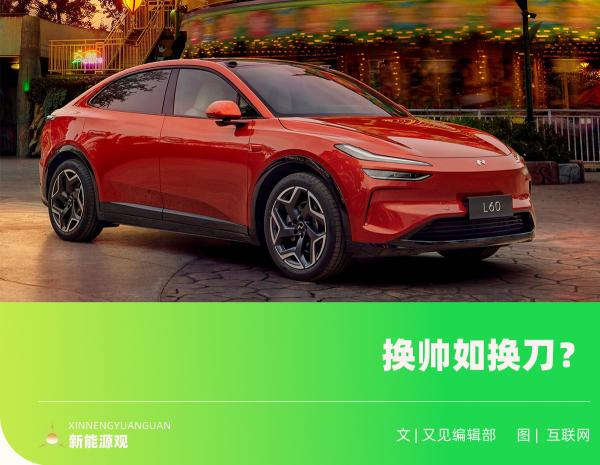
Original by New Energy View (ID: xinnengyuanqianzhan)
Full text: 3286 words, reading time: 10 minutes
Ai Tiecheng has paid the price for the military order he once made, transitioning from President of Letao to former President of Letao, with Shen Fei, the former head of NIO's energy business, taking over as President of Letao.
Leaving Letao must have been a difficult decision for Ai Tiecheng, especially as he had explicitly stated just half a month earlier that he would "never give up halfway."
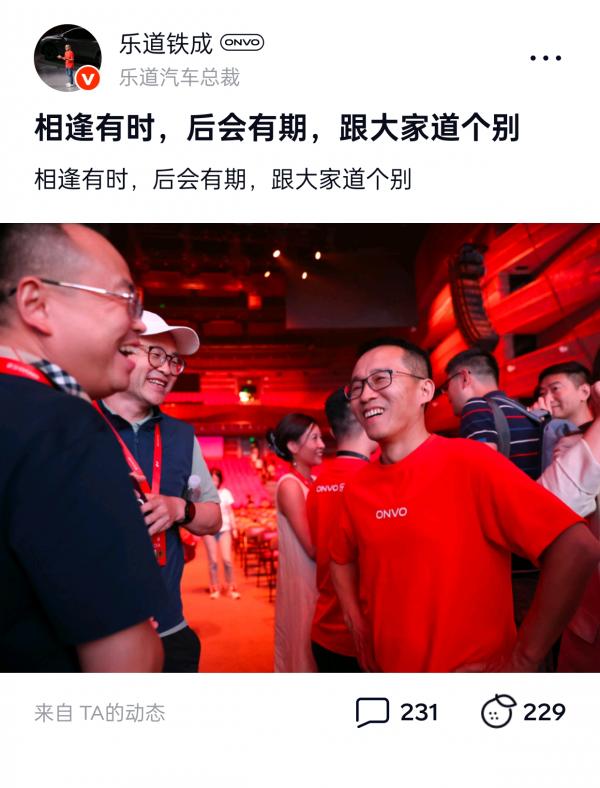
Image/Ai Tiecheng's farewell post
Source/Screenshot from New Energy View on the internet
Li Bin did not give Ai Tiecheng a chance to redeem himself either, which on the one hand confirms that Li Bin is not a "pushover" in management, as he has let more than 20 VPs go in the past decade, and on the other hand, it shows Li Bin's tough attitude and determination regarding NIO's goal of achieving profitability in the fourth quarter of 2024.
However, behind this confidence lies the harsh reality that NIO's net loss in 2024 widened to 22.4 billion yuan, and that its sub-brand Letao is currently only achieving one-third of its monthly sales target.
As the vanguard of NIO's "downward strategy," Letao L60 was once held in high hopes for boosting sales volumes but has now become a "scapegoat" in financial reports. After all, according to Li Bin, Letao needs to sell 20,000 to 30,000 vehicles per month to achieve break-even.
Achieving profitability has become NIO's primary task and core objective for this year. In other words, to achieve profitability, NIO will use every method allowed by law, including layoffs.
In fact, layoffs have been quietly taking place within NIO recently. According to insiders, this round of layoffs at NIO involves multiple departments, including after-sales customer service, the energy department, NIO House operations, etc., with a layoff ratio as high as 10%, and even exceeding 50% in some regions.
We can't help but wonder, by the fourth quarter of 2025, will this profit self-rescue effort from NIO ultimately come at the expense of Letao?
1. From once being "overwhelmed with orders" to now being abandoned by consumers?
After the launch of Letao L60 in September 2024, Ai Tiecheng expressed in a conversation with Li Bin that orders had exploded.
Although the specific number of orders was not announced later, Ai Tiecheng set a flag to "reach 15,000 in January-February 2025 and deliver 20,000 in March" and said, "If not, I'll step down."
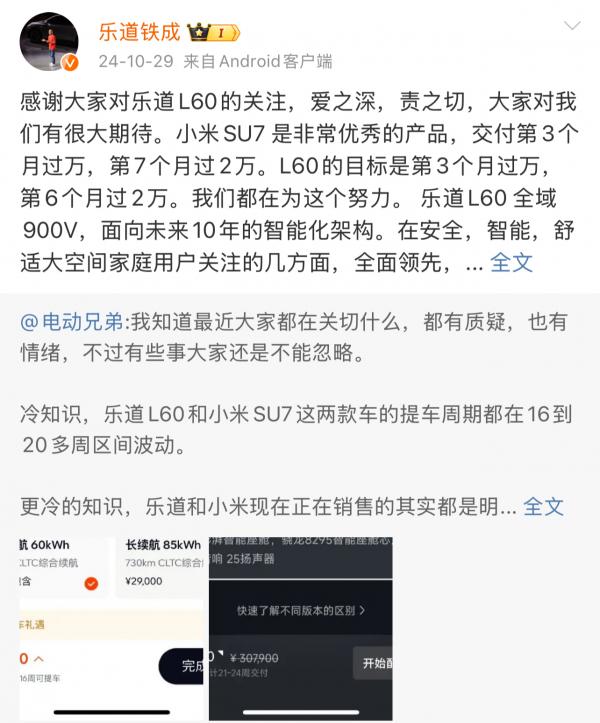
Image/Ai Tiecheng announcing sales target
Source/Screenshot from New Energy View on the internet
Now, the declining sales data of Letao L60 at the beginning of 2025 has not only dealt a blow to Ai Tiecheng but also turned the boast of "orders exploding" into a ridicule meme created by netizens, bringing shame to both NIO and Li Bin.
Data shows that Letao L60 sold 5,912 vehicles in January, nearly half of the over 10,000 vehicles sold in December of the previous year; 4,049 vehicles in February, and 4,820 vehicles in March.
Many consumers who have recent car-buying plans have expressed obvious hesitation when talking about Letao L60. "I used to be quite optimistic about Letao L60, with its good price and configuration, but later, negative incidents such as forcing employees to buy cars and delivering cars out of order frequently appeared online, which made me hesitant."
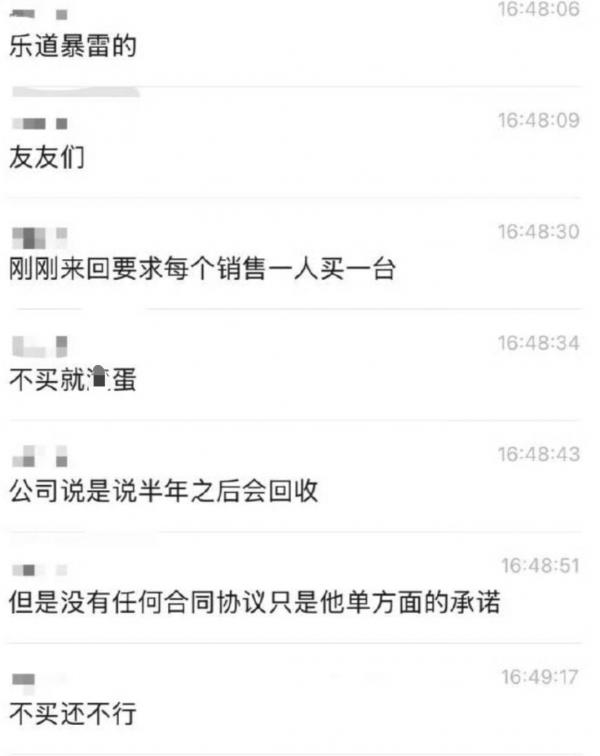
Image/Netizen exposure
Source/Screenshot from New Energy View on the internet
"When choosing a car, you have to look and compare more to select the one with the highest cost-effectiveness, best quality, and most reliability. Now there are many car models to choose from within a budget of 200,000 to 300,000 yuan. In comparison, Letao L60's advantages are not prominent."
In contact with many consumers, we have gradually discovered that Letao L60 is not only struggling to attract new consumers but even the first batch of car owners seems to be gradually "deviating."
Huang Yunwen (pseudonym) is one of the first batch of Letao L60 car owners. Recalling her car-buying experience, she said she was initially attracted to Letao L60's battery leasing plan, thinking that leasing was more cost-effective than outright purchase. "I placed an order for the price of 149,900 yuan, but later found out that the long-term usage cost was not low, even much higher than competitors."
Huang Yunwen introduced the "trick" in the battery leasing plan. Taking her 60kWh standard version of Letao L60 as an example, the monthly rental fee is 599 yuan, with a promotion of "buy four, get one free." Renting the battery for five years will cost nearly 29,000 yuan, and buying it out after five years will still require a payment of 43,000 yuan. Together, the subsequent usage cost has completely covered the 57,000 yuan saved by leasing instead of buying. "It really lives up to the saying, 'the wool comes from the sheep.'"
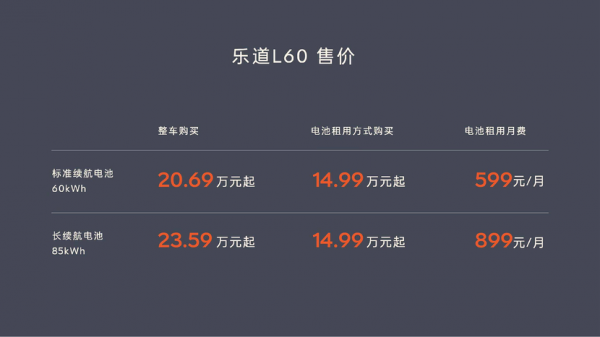
Image/Letao L60 price and battery leasing plan
Source/Screenshot from New Energy View on the internet
Many Letao car owners share the same view as Huang Yunwen. On third-party social platforms, several Letao L60 car owners have posted that they will not prioritize Letao for their next car.
"If you don't buy it outright, you have to keep paying. If you buy it outright, you still have to pay for the battery. Rounding up and down, it's like being reverse-fleeced by the car company." "I feel like leasing a battery is no different from buying a car on loan; it's just buying the brand's financial product."
In addition to the battery leasing plan, some car owners are also dissatisfied with the 900V high-voltage architecture equipped on Letao L60. They feedback that due to the fact that most charging piles are still 400V specifications, the 900V high-voltage architecture does not bring significant advantages in actual use and is more like a "decoration."
From being in the limelight at the beginning of its launch to now seemingly losing momentum, what is the problem with Letao?
2. Backed by a "big tree," why has it fallen into the trap of "high opening, low closing"?
During NIO's fourth-quarter 2024 financial report meeting, NIO Chairman Li Bin stated that the recent intensification of market competition and the frequent occurrence of negative public opinion have had a 30% to 40% impact on Letao's order volume.
However, Ai Tiecheng's sudden resignation seems to indicate that Letao's predicament is not as simple as Li Bin described.
In the actual feedback from many consumers, the underlying reasons for the decline in Letao L60 sales are gradually emerging—perhaps stemming from its complex relationship with its parent brand NIO.

Image/Li Bin replying to Ai Tiecheng's tweet
Source/Screenshot from New Energy View on the internet
Ren Ze (pseudonym) from Beijing bought an 85kWh version of Letao L60 in December of last year based on the phrase "NIO's budget alternative." "When buying Letao, the salesperson said it could share NIO's battery swapping network, but in actual use, many swapping stations are not compatible with Letao's batteries, which makes me particularly anxious during long-distance travel. I have to plan my route in advance to find a place where I can swap batteries, which is very troublesome."
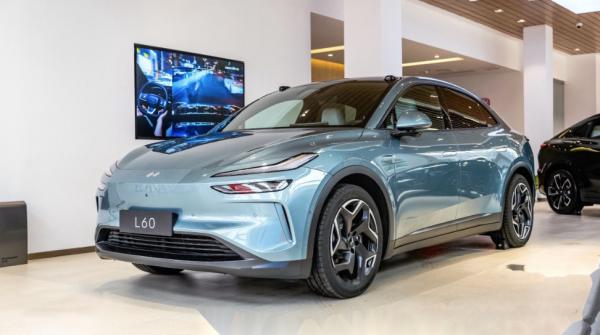
Image/Letao L60
Source/Screenshot from New Energy View on the internet
Most of the first batch of Letao L60 car owners, like Ren Ze, are experiencing the frustration of insufficient compatibility of NIO's battery swapping network with Letao models. They say that NIO's battery swapping station layout and upgrade speed are concerning. "Sometimes, after finally finding a third-generation station, I am restricted by the small number of batteries available for Letao in the swapping station."
It is understood that although NIO has over 3,200 battery swapping stations, only some modified third-generation stations and newly built fourth-generation stations are compatible with Letao models. As of February 9, there were only 1,309 available swapping stations and about 2,100 available batteries nationwide for Letao.
In addition to the weakness of the battery swapping network, Letao has also been criticized by consumers for its service experience. Within a month of the launch of Letao's first model, the L60, prospective car owners began posting online that there were issues with Letao L60's slow delivery and even disorderly delivery sequence.
Although Letao officially provided an explanation and apologized to consumers immediately afterward, the occurrence of this phenomenon will inevitably cause some dissatisfaction among consumers.
Even more ironic is that NIO's own financial pressure seems to be constraining Letao's development. From 2021 to 2024, NIO's net loss continued to increase, reaching 4 billion yuan, 14.4 billion yuan, 20.7 billion yuan, and 22.4 billion yuan, respectively. At the same time, years of consecutive losses have also made NIO's current liabilities reach 62.31 billion yuan, exceeding current assets by 420 million yuan.
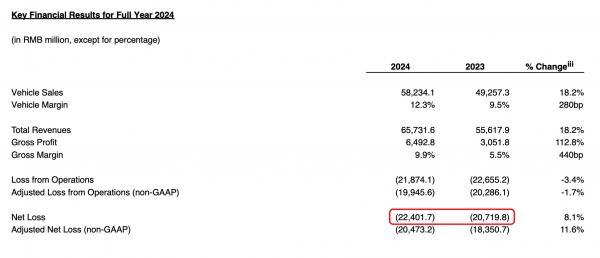
Image/NIO's net loss from 2023 to 2024
Source/Screenshot from New Energy View on the internet
Under this situation, Letao L60 must not only bear the heavy responsibility of "boosting sales" but also avoid competing for resources with its parent brand, inevitably leading to product positioning confusion and low supply chain efficiency.
Most consumers believe that Letao's main advantage of "high cost-effectiveness" is not very competitive in the market compared to other new energy vehicles. At the same time, compared with NIO's third brand, Firefly, which is about to be launched, Letao has obvious shortcomings in service. Firefly will be sold in NIO stores and share NIO's service system, while Letao can only be sold in its own stores, greatly compromising the comprehensiveness and convenience of its services.
Industry insiders say that Letao's positioning is not very clear, as it wants to leverage NIO's high-end aura while also being eager to penetrate the lower-tier market, ultimately pleasing neither side.
As a result, Letao, which should have risen rapidly relying on its parent brand's technology, channels, and user base, ultimately finds itself in a dilemma under NIO's aura.
3. Amputation for survival? Speculation on Letao's final outcome
In 2025, against the backdrop of NIO disclosing its record-high net loss for 2024 and the official launch of its third brand Firefly's first model on April 19, Letao's fate may have reached a critical window period: if NIO chooses amputation, Letao may be sold or shut down; if it continues to provide blood, it will have to face multiple competitions from the market head-on.
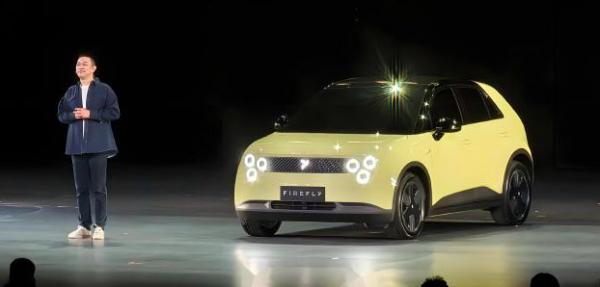
Image/Letao Firefly
Source/Screenshot from New Energy View on the internet
According to incomplete data statistics, there will be over 140 new energy vehicle models launched in the domestic new energy market in 2025, including models such as the AITO M8, XPeng G7, and Lixiang i8.
In this relatively unfavorable situation, not only are Letao's executives uneasy, but also over 30,000 Letao car owners.
Letao L60 car owner Huang Yunwen frankly expressed her concerns. "Letao's stores are independent. If they close down in the future, even if after-sales support is provided by NIO, it will inevitably be discounted. The official promise of free roadside assistance within the vehicle warranty period and not returning to the store for maintenance for three years may become a mere piece of paper."
"Although some areas of NIO's 'NIO House' are also accessible to Letao car owners, in reality, Letao car owners still cannot enjoy the same rights and privileges as NIO car owners in the 'NIO House.' If Letao stores close in the future, will Letao car owners be treated equally to NIO car owners when they go to NIO service centers for vehicle repairs?" Ren Ze, a Letao car owner from Beijing, voiced his concerns.
Several prospective car owners who have recently purchased the Letao L60 said that aside from the imperfect battery swapping network and the chicken ribs battery leasing plan, Letao, after all, uses NIO technology, and its quality-to-price ratio is definitely more trustworthy than other second-tier new forces. "I hope Letao can find a stable growth point as soon as possible and not betray the trust of us car owners. After all, no one wants to buy a new car that turns into an 'out-of-print' car overnight."
In fact, judging from NIO's current actions, it has not truly given up on Letao.
At the end of February, NIO officially released an organizational announcement, merging the delivery channels of its dual brands, NIO and Letao, to share after-sales resources.
The following month, NIO CEO Li Bin stated at a closed-door communication meeting that NIO will fully implement management measures of the CBU mechanism this year, breaking down all aspects of research and development, production, marketing, etc., into 12 independent core units, with each unit having clear ROI indicators and a performance reward and punishment system.
In addition, Letao's second model, the L90, is expected to debut at the Shanghai Auto Show at the end of April, positioned as a six-seat family SUV. At that time, according to NIO's previous plan, Letao is expected to have access to 2,000 battery swapping stations.

Image/Letao L90 spy shot
Source/Screenshot from New Energy View on the internet
However, whether these measures will work still needs time to test.
It is worth noting that after Firefly, targeting the 150,000 yuan high-end compact car market, is launched, it may divert some of NIO's attention and resources. After all, Li Bin has previously stated that he will establish separate battery swapping stations for Firefly. So, can NIO strike a balance between its three brands in the future, and what changes will Letao, with its new leader, usher in? We will continue to follow up.








